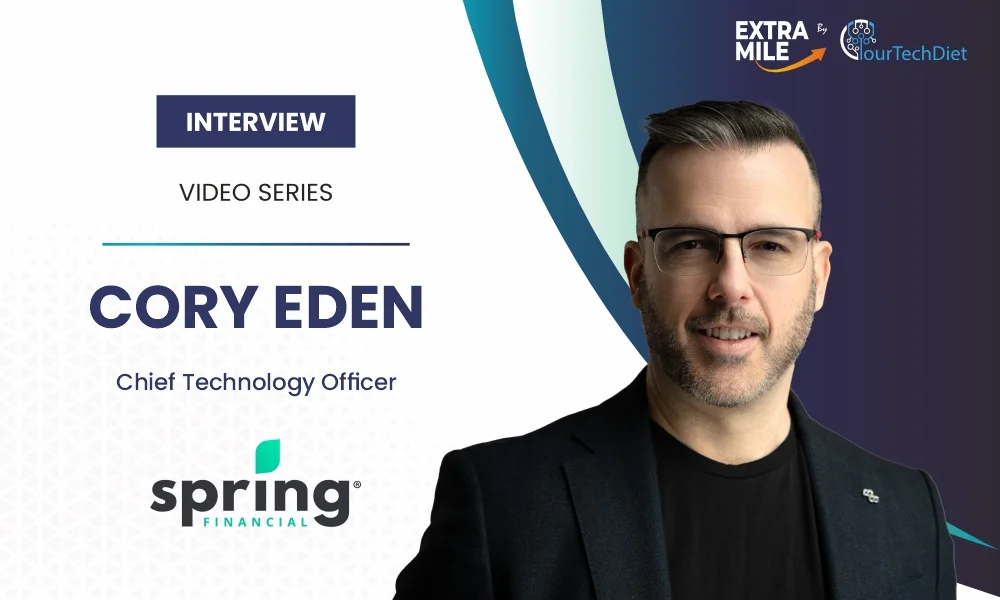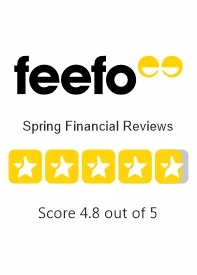Welcome to another episode of ExtraMile by YourTechDiet, an interview series where we feature the minds shaping the future of the tech. I’m your host Sayali and today we’re thrilled to be joined by Cory Eden, VP of technology at Spring Financial. As a Canadian fintech leader, Spring Financial builds a digital product that helps improve financial well-being through better credit access and smarter savings.
Cory brings over two decades of experience leading tech transformations across firms like HSBC and Amazon. At Spring Financial, he’s driving operational excellence and building scalable, accessible financial solutions. Today, we’ll uncover Cory’s insights across industries and how Spring Financial is redefining financial accessibility for Canadians.
Cory, it’s a pleasure to have you here. Very warm welcome to you.
And, you know, there I learned that one of the most challenging things is working with people. You know, when you have people distributed across so many countries and trying to get them all pulled in the same direction, it’s a very interesting challenge. At Amazon, I had the opportunity to, you know, launch an AWS service from scratch.
And, you know, that was a very exciting opportunity as well. At Spring, you know, we’re trying to help underserved Canadians who are not well served by the current market. And there’s a number of things that we’re trying to do to help them.
You know, one of the things is using AI, looking at non-traditional data points to help identify customers who we can have provide products who might be overlooked by, you know, banks with more traditional models for assessing customers. And we’re looking to grow with customers through their journey, where today we help them, you know, connect with the financial industry. We want to go beyond that and be their trusted partner for them as they grow in their lives and move on.
And to do that, we really need to move more quickly. And one of the big changes I’m doing here at Spring is moving from like a project mindset where from a tech perspective, we focus on executing on a particular deliverable for the business and really just having a broader perspective and thinking of ourselves as product owners, where we bring a understanding and a connection with the technology and partnering with the business to define like what is the best solution for the long run.
And to help us do that, you know, I’ve organized us around that tech product ownership with clear single-threaded owners, leveraging the single-threaded owner model. And this really drives like a greater degree of ownership and long-term thinking for the team. And so, this is one of the key changes that I’m making at Spring to help us grow the business and achieve that vision I was mentioning.
Host: So, Cory, speaking of your tech background, your experience spans across cloud finance and logistics. Which industry posed the biggest challenges and how did you navigate them to ensure sustained success?
Cory: I think they all had interesting challenges, but I think the definitely the most difficult challenge was launching a new service at Reinvent. That was a very challenging little crunch period for myself in my career. But if I take a step back, you know, I already mentioned at HSBC that relationship was really a critical and important skill to be successful.
You know, one of the things you find that if you’re in a disagreement with a person, often the disagreement is not centered around like specifics of the, you know, individual thing that you’re talking about. It often relates to like different value judgments of, you know, how people assess different things, or there may be unstated factors such as like different incentives or deadlines that you’re not aware of. And so, you know, one of the things I really learned at HSBC is like connecting with people and understanding a lot of what’s going on behind the scenes with them.
And once you understand and connect with someone and like bring up a lot of these details, you can often find a solution and it’s often not the first solution that you thought of. So, I think that’s one of the key things that I learned from HSBC. Then when I shifted over to Amazon, I had kind of two major chapters of my time in Amazon.
First was Amazon Logistics, and the second was AWS. So at Amazon Logistics was quite an interesting and exciting time. Right when I joined was when Amazon decided to start building their own logistics organization.
Prior to that, all the deliveries were done by third parties. And so, you know, I was part of that and I got to see that from the inside. In just a few years, going from nothing to like one of the largest logistics organization in the world was quite an amazing journey.
So, my part in that was tracking the Truxton Logistics Network. So I dealt with like many sensors such as GPS, LiDAR, cameras, also integration with different systems, and also some manual signals reported by the people. And just trying to make sense of that and trying to match the virtual world to the physical world.
And I joke during that time that we had to deal with the messy, messy real world, because when you’re dealing with, you know, trucks and warehouses and people, things never go to plan. And you’re always trying to figure out what is actually happening from a system perspective, dealing with that virtual, physical mismatch, and, you know, often getting conflicting signals and trying to figure out which one is right. And so there, I think the thing, the key to success for me was really getting a deep sense of how things actually worked.
And so that meant going to the warehouses, talking to the people, seeing how things worked, riding on trucks, really appreciating it for myself and deeply understanding that context matters as well. You know, one warehouse might be five football fields wide and might have like robots and, you know, a lot of things like that. Another one might be just like a shipping container on the side of the road that someone is just working out of with a few packages.
And so really getting a sense of what’s actually happening on the ground was really important. It was quite a journey. Yes, it was really, really exciting.
At AWS, a couple of different challenges. The first one is that just operational resilience and how the service performs is part of the core value proposition for AWS. And so really diving deep and thinking about security, compliance, billing, operational readiness.
You know, people really don’t like it when you don’t bill them the amount of money. And they would not expect that from AWS. The other really interesting challenge working at AWS, which is in quite a big contrast to Amazon Logistics, is how disconnected you are from the customers.
You know, in Amazon Logistics, I could go to the warehouse, I could talk to the people, I could see how they’re using the system. But at AWS, people are kind of just like nameless faces. You never really talk to them.
And you’re trying to figure out why they’re using your service in a certain way or what they like, what they want. And so there, it’s really important to like dive into the data and have a hypothesis-driven product development where you’re, you know, trying to assess, you know, based on larger trends at the data, what people want and why. I would say that the common success factor for me across all of these is just having a sense of curiosity.
Why do things work a certain way? You know, how could they be different? What would happen?
And never being afraid to ask the dumb question. There’s so many times when I ask like a really simple and basic question and people are like, well, I never thought about that. Like, let’s figure that out.
That’s a good question. And the last thing I would say is just going back to the people thing is like just having empathy for people and building connection with them. I think to be successful and to enact and drive change, you really have to connect with people.
Host: Absolutely. Thank you for sharing that with us. Moving on, how has technology transformed the financial sector in recent years? And what innovations do you believe will push the next wave of disruption?
Cory: Sure. The first thing I would say is that the technology innovation is at the societal level and it’s really driving changes and expectations of everything. People demand things now, they demand them seamless, they demand them everything to work together.
And so, it’s not just in finance, it’s broadly across the whole society and that’s kind of bleeding into, you know, finance as well, for sure. You know, banks have been unable to keep up with this. You know, a lot of them have legacy mainframe systems.
They have existing profitable business models based on like physical locations and things like that. And, you know, it’s hard to like disrupt your own business. So, they have some like reverse or negative incentives for change there, you know, and out of that comes kind of like the fintech world.
You know, there’s been a lot of innovation in the fintech world. I think in Canada, we’re a little bit behind. Some of the regulations from an open banking perspective are a little bit behind what there is in the US.
We have some open banking regulations now in discussion and we’re really looking forward for those to help us innovate even more. But, you know, what we see now is, you know, data starting to be traded and passed back and forth between organizations using services like Plaid and Flink. And it would be really hard to imagine, even just from a customer perspective, for them being comfortable with that five to 10 years ago.
And now, like without too much of a second thought, they provide their credentials and their data moves around. So, it’s just a very different world we look in, we live in. I think that, you know, on top of that kind of baseline, what do I see from a further transformation in this domain?
One of the things that really comes up to me is that we are trying to divide or devise seamless and best-in-class user experiences to drive customer pain points that people feel. But I think increasingly, we’ll not be dealing with people, we’ll be dealing with the AI agents who are acting on behalf of the people. So rather than someone going to a website or using a mobile app, they might just ask their phone, like, hey, what should I invest in?
Or, hey, I want to buy this bike, how do I get some money for this? And like, the AI agent itself will go, oh, here’s Spring Financial, they’re consumer lending. They have good deals for you if you want to buy, you know, a motorbike or something like that.
So really moving beyond thinking of just building services for people, but to building services for AI agents, I think is the next big thing.
Host: Absolutely. So, moving on, Spring Financial recently partnered up with Ratehub.ca. So how will this partnership enhance your tech infrastructure and strengthen financial solutions for Canadian users?
Cory: So Ratehub is a great company that helps Canadians compare financial services. And I think it’s just the continued growth of us looking to partner with other companies who are aligned with our values and what we’re trying to achieve, and to enable customers to discover our products so that we can fulfill our vision to help those customers who are underserved. I think also beyond just that kind of product and business dimension, it’s also just continuing our journey from an API-first development.
And that goes back to the point about building systems for AI. You know, there’s multiple aspects to that. But one of the first things is to have really robust, clear, well-documented, and semantically consistent APIs that are easy for everyone to use, including other partners that were AI agents.
We’re also looking, we’re always looking to grow our partnership ecosystem. We have many partners, both for customers, but also from a product perspective as well, and what we offer our customers.
Host: As we know, scalability is a core factor in product development. So how do you ensure your financial solutions are scalable while remaining accessible and transparent?
Cory: Sure. So, whenever I think about scalability or resiliency or any of the many words that end with E, I think it’s important to think about it from the beginning, or if you never thought about it from the beginning, start thinking about it. But think about it holistically.
You know, some people in the tech world, sometimes they think of themselves as a coder or a developer for a particular language, or they might be thinking of it from a system admin perspective or from a DevOps perspective. But to really solve the problem in the best way and to consider all of those non-functional requirements, you really have to think holistically. How does everything fit together?
What is the customer experience? Like, what are all the tiers of the infrastructure and the architecture that a particular request goes through to provide that customer experience? If you use a particular combination of a hosting platform for compute or a particular language or, you know, a particular way you distribute the processing across components, like what does that end result in and how do you ensure that it’s scalable?
Where’s the bottlenecks? Where’s it going to break? And so, I really look for people who can help think of the holistic end-to-end mindset.
The other thing is from an accessibility perspective, I think there’s like the base and standard aspect of accessibility from the technical side, like, you know, the web accessibility standards and stuff. But when I think about accessibility, I really think about transparency of both the financial products, what are being offered, what they mean for the customer, and also what are we doing with your data? So, I think it’s really important to build trust with customers, building systems that like respect customers’ data, treat it appropriately, provide clarity on, you know, what are the products they’re getting and how their data will be used.
And I think then connecting that to with the long-term vision to build that relationship with the customer that they can trust free financial.
Host: Now, coming back to AI, it has transformed personal finance from budgeting to transaction tracking, everything. But is full AI integration into finance really safe? And like, how do you see it evolving?
Cory: So, I think it’s a great question. And I will readily admit, I don’t have all the answers on this particular question. I think that this is a question that everyone is grappling with to some degree across pretty much every industry.
I would say that, you know, pretty much everyone in the software industry, regardless of where you’re working, is looking at how AI can transform both how they work, but also the products that we offer our customers. And there’s a really key question here, especially as it relates to data. You know, we have a large amount of data and compute in the cloud and some really amazing models that we all have access to that are empowering for customers.
But, you know, that also risks exposing customer data when leveraging some of those services. So, there’s multiple options on how to handle that. You know, you can leverage smaller models that may run on edge devices.
You can leverage custom or hosted models that run in sandboxes to protect data that’s obviously slightly more complex, may have higher hosting costs and things like that. So, I think there isn’t really a right answer at this point. I think the most important thing is to just be aware of the options that we have in terms of how we use AI and what is the implications from a customer data perspective, from a customer safety perspective for each of these options, and really just review that on a case-by-case basis.
And looking at like the governance models for how you make these decisions is also important. You know, do you want like an individual developer or just a team lead making these decisions? Or do you want to have the opportunity to raise some of these questions up to like a higher leadership level and reflect on like what is your overall strategy and like providing guidance to your teams on how they should think about some of these things.
I think that in addition what I would say is that there’s no going back. You know, going back to something we talked about earlier, how you asked about technology change for finance. And I was talking about how it’s actually society’s changing that’s driving the broader expectations for everything, including finance.
I think it’s the same thing here. You know, we’re going to be expected to leverage AI in ways to provide customers insight that they might not otherwise get. I think it’s a very empowering opportunity for this particular area.
You know, some, if you have a lot of money, you can probably hire like very nice financial advisors and they can give you, you know, all kinds of insight into how the market’s working, how to think about different types of more complex trades, maybe like, you know, currency markets or options trading or something like things like that, that, you know, regular people will never think about. And like the type of understanding that will be available to everyone’s fingertips now will be, you know, transformational.
Host: Absolutely. Now let’s talk about leadership. So, Cory, what’s your approach to team building and how do you find and retain the right tech talent?
Cory: Sure. So, I kind of talked about one thing earlier that is kind of key for me. You know, I’m not looking for people who are experts in a particular skill or particular technology or particular language in, especially, you know, as AI grows, the ability to like work in any language or to solve a particular technical problem in a particular domain has become increasingly democratized and in many places automated.
I think where people really differentiate themselves and add value now are those people who can think creatively about how you solve problems, understanding the business problems, understanding your building blocks as a technical person, as a leader, and thinking how you can put them together and having demonstrated impact where they have done that and they’ve really moved the needle for their team or business. So those are the type of people that I look for and that I want on my team.
In terms of like building a team, you know, I’m a big believer in the single-threaded model. I mentioned that earlier. I went out my time on Amazon.
That’s something that I personally enjoyed. I found it really engaging and empowering to know like what I’m responsible for and being empowered to go make the decision, whatever I think is best and how I think it’s best. And then the phrase that I always use to like reflect on that is to succeed or fail on my own merit.
I enjoyed the ability to succeed or fail on my own merit. It is a double-edged sword because, you know, if it doesn’t go well, there’s nowhere to hide. It’s clear who was responsible.
I think a couple of things I would say on in addition on the S2M model and how I think about this. It’s important to also have transparency and accountability in terms of metrics or mechanisms and processes. You know, the single-threaded model, it’s empowering and it’s engaging for the team, but it doesn’t mean they just go do whatever they want and they have, you know, no accountability to, you know, on something.
So, whether that’s regular business reviews or you have clear goals and expectations on a particular metric they have to drive, I think it’s important to have that as well. The last thing I would say from a team building, and there’s many dimensions to this, but like one that just comes to mind that I think is really important to create the right team environment that I’m trying to create, is just to create a sense of psychological safety but with high standards. You know, what does that mean?
I want people on my team who are encouraged to innovate, they’re encouraged to take risks, they’re encouraged to move fast. If people are scared that if they make a mistake that they’re going to get in trouble, people are going to yell at them or worse, you know, that has the perverse effect of like creating a very conservative environment where people move very slowly and they may not try new technologies or new approaches, you know, nobody ever got in trouble for just doing the same thing over and over if it has been working for a while.
And so, I really think it’s important to create that sense of safety, you know, what does that mean? That means that, you know, if there is a mistake, you do have to review it, but you don’t look at it from an individual blame perspective, take a chance to like look at the broader systemic issues or the environment that existed in which that mistake was made and identify those root causes and propose actions for fixing those and use it as an opportunity to learn and do better. You know, I think when you make a mistake, if you learn from it and you do better next time, that’s the best thing.
It’s only when you make the same mistake two or three times over and you haven’t learned from it the second or third time, then you have a more serious problem that needs to be addressed.
Host: That’s a great approach and lastly, we know that compliance is very essential in fintech. So, what’s your take on balancing innovation with regulatory adherence and what strategies do you recommend?
Cory: Sure. A couple of things I’ll say like first is that at AWS, I had the opportunity to work on compliance quite a bit. AWS has many, many different compliance regimes.
So, I had an opportunity to dive in and understand a broad swath of compliance regimes. And I would say that, you know, my observation is many of these are very similar and at heart, a good many of the controls and different compliance regimes boil down to like do things properly. And so, if you do things properly from the beginning, you are in a much better place when it comes to compliance.
And what does do things properly mean? It means like have high standards from security and reliability perspective, ensure you have proper authentication and proper validation, make sure you’re not logging customer PII, ensure that you’ve locked down your production systems and they’re not accessible to anybody without checks and balances in place to get access, ensure that you have proper monitoring and alerting, ensure you have repeatable deployment processes and things like that.
And if you go through this checklist, which I would put in the frame of like an operational readiness checklist to do software engineering properly, to monitor and manage your software properly in production, I would say that like that’s 70 or 80 percent of most compliance regimes. Beyond that, I think there’s like a governance piece for many different aspects of things. And, you know, there’s some specifics to different compliance regimes that you need to understand, which takes some time.
But first and number one thing I would say is do things properly, build software properly. The second thing I would say, which is kind of extension from the first, but maybe I’ll add a bit more detail, is automation is the key. You know, all of these things that I mentioned, they can’t rely on anyone manually pressing a button or manually going and checking something or manually deploying this or manually changing this.
Everything has to be automated. In addition, we need automated checks. And I think AI gives us some really interesting opportunities now.
For example, you know, AI code reviews is an amazing tool, you know, to proactively detect, hey, someone is about to submit a PR where they’re going to be logging a customer address to a, you know, to your debug log or to your, you know, error log, you know, and having the AI system call that out and raise it. So just look at automation and what checks and balances you can have in place so that you know immediately when something is not right.
Host: All right. Cory, thank you so much for joining us today. Your insights into emerging technologies, leadership and fintech innovation were truly valuable to us.
It is clear that Spring Financial is paving the way for a more inclusive and tech-driven financial future in Canada. Once again, thank you so much for being part of this episode.
Cory: Awesome. Thank you so much.
Host: And thank you to all our listeners for tuning into this episode of ExtraMile by YourTechDiet. I’m your host Sayali, signing off for now. Catch you in the next session with another expert who’s shaping the future of tech. Until then, stay curious and stay tuned.





